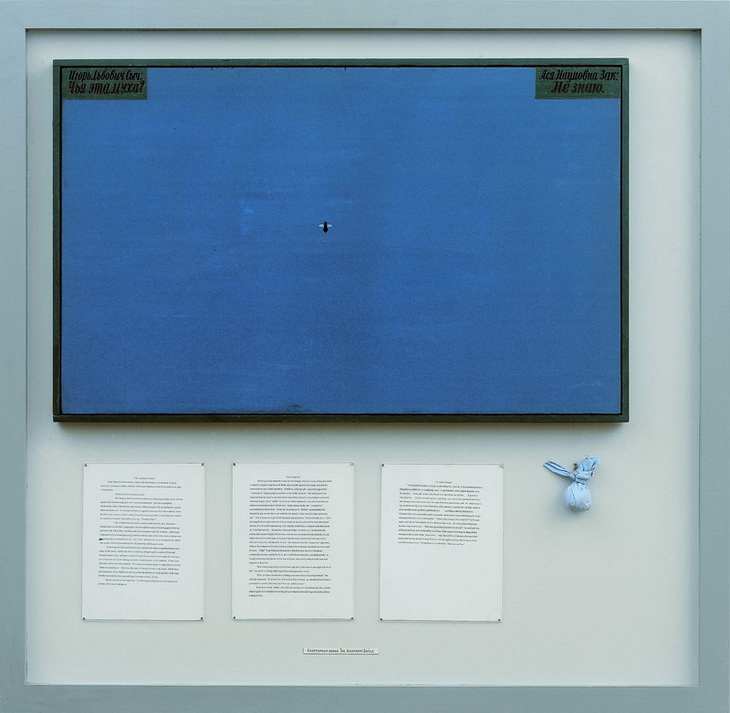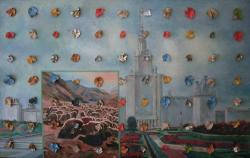

_large.jpg)
Ilya Kabakov
The Apartment Battle
Ivan Nikolaevitch from the corner room had a major conversation. Or more precisely, a strange incident with the old women Sukhanova who lives in the room next to the kitchen. But let’s tell everything in order.
The thing is that for a whole month now, beginning in May, an all-out war against flies has been raging in our communal; apartment. The flies multiplied innumerably, first in the kitchen, then armies of them began to fly around I corridor and in all rooms. On Sunday morning at a general meeting of all residents, it was decided to give them a battle and a poster was hung up in the corridor that was created by our senior resident, Starodubovy saying: Death to Flies!
The children ran around the corridor with butterfly nets. Residents bumped into one another, banging the cabinets and the walls with newspapers rolled up into tubes, the old women Aniskina and some assistants made fly-swatters. And Sergei Aleksandrovich invented special fly catchers that he made in his own room so the process for making them remained a secret. This war united everyone in our apartment, which was usually filled with an atmosphere of animosity and disagreements.
Now everyone discussed in a friendly manner who had managed to destroy how many of the enemy, and by the fifth or sixth day of fighting the number of flies had dropped significantly, and they could be found only in certain places under the ceiling or you could spot one or two racing around in complete panic in the shadows. It was clear that the total victory was close at hand. The inspired residents began t make plans for a new battle for cleanliness. This time the topic of discussion was cockroaches, which were also numerous., all you had to do was to go into the kitchen at night and turn on the light. But the war with the flies inspired hope for a new victory, if only … But let’s turn to the beginning - to what happened between Ivan Nikolaevich and the old woman Sukhanova.
That’s My Fly!
Thing is that when the residents were finally close to victor, it was decided to conduct a complete inspection of all the spaces in the apartment to make sure that the cursed insects didn’t hide anywhere. Therefore, a few people, a specially appointed commission, began going around the rooms of the residents. The next place to be inspected was the small room near the kitchen where Anna Ivanovna Sukhanova resided, who was simply called Babka by everyone in the apartment., since she lived all alone and no one knew how old she was. Quite unexpectedly, the commission encountered resistance here. At the knock on the door, Babka answered that she does not let anyone into her room, and she does not “have any flies there and never did”. But in response to persistent demands and a threat to “break down the door”, after prolonged silence and some sort of noise in the room, from behind the door they heard that the door would be opened only very slightly so that could just stick their heads in. Ivan Nikolaevich – he was the chairman of this commission, looked into the crevice that opened slightly before him, and saw a room cluttered with all kinds of junk where here was so little light coming through the dusty window that not only was it difficult to see a fly, but the table as well. He wanted to end the inspection right there, when to his indignation he felt something land on his forehead and star to move toward his nose. “A fly!” Ivan Nikolaevich understood with horror, but since his hands continued to remain outside the door, he could not brush away the cursed insect, who as though understanding that its victim was in a trap, very calmly settled on his nose and began to look at him.
“How can you say that you do not have any flies, when here is one right in front of me!” was all he could say with desperation and anger in his voice.
“Well, you have no business sticking your nose where it is not permitted!” the old lady answered. “You have lots of homeless flies out there, go ahead and beat them to your heart’s content, but I only have this one, and it is mine!”
With these words Babka shoved Ivan Nikolaevich’s head back into the corridor, slamming the door and almost catching his nose that had already begun to swell and was itching terribly.
A Sack of Sugar
“So what did I need to stick my head in there for, after all, it has been known for a long time now that she is completely crazy”, Ivan Nikolaevich thought to himself, once he was free- “although, on the other hand, how should we see al this… A person is old, all alone… People in such a position get dogs, cats, and in the apartment next door the old man even took a rooster, he walks him on a leash in the yard. So, what can you say, in all truth a fly is no worse than these other animals, it guards the old lady, and you do not need to clean up after it and it eats less…” And then suddenly before Ivan Niolaevich’s eyes appeared a small sack made out of a white material hanging by a rope and attached to the small vent window. “What is this strange little sack for? He thought again, just like he had when he first looked into the room. All of a sudden everything very clear to him – “This was apparently lunch for her friend!” he said and only at this point did he notice that all the members of the commission were looking at him, waiting for the results of the inspection. Only then did Ivan Nikolaevich come to his senses and turn his attention away from his own thoughts and was able to say in a firm and authoritarian voice :”Everything is in order here. There are no flies”.
Ilya Kabakov
Dialogue between Ilya Kabakov and Pavel Pepperstein.
Pepperstein: We now begin a discussion of the series “Holidays”, a series of works done in oil, on the surface of which are equally distributed bright, shining pieces of multi-colored foil, resembling candy wrappers of artificial flowers. In the dialogue “Boar”, A. Monastyrsky defined this series as the continuation of developments in the tradition of “frames”, “shells” forming an empty center. The center is always the carrier of ideology, and only by ensuring its emptiness can you attain the de-ideologization of the work, the absence in it of a lie. In this case the center is de-ideologized via the gluing of “candy wrappers” resembling shells with an extracted or absent content onto the painting’s surface…
Kabakov: This interpretation is completely accurate. In actual fact, we are talking about a certain shining emptiness, laid-out in such a way so as not to be visible. It is also important that from the very beginning these painting were done not by an artist, but by a “personage” by “someone”. I would like to say a bit about the two “times” present in this painting. It is assumed that a certain nameless hack artist, approximately thirty years ago, received an order to make this series of works for decorating either the House of Scientists, or a collective farm House of Culture. The series accurately represents various achievements in different fields of the economy and culture during that time. But the main theme of the works is joy and exultation. For some reasons, the paintings were never sent and remained in the studio until recently. Again dragged out into the light of day, these works filled the artist with revulsion because all their light and energy have disappeared, the paint has yellowed, they are covered with dust, everything has been transformed into boring murk. And a new impulse emerged for the artist: to renew the series, to return to it once again those qualities that it once possessed, to re-inject those feelings of joy and exultation that were previously present and that were supposed to be there. It is possible that now, after the course of many years, he is compelled to realize these works. One could redo the paintings with rich, bright, emotional colors. But he has neither the strength nor the time nor the desire to do so. But the determination to make them cheerful and bright wins out. And he runs to the strangest method form injecting joy – namely, he sews on these flowers. Time splits in these works. On the one hand, it is old hackwork, made as something remarkable but that by now has lost this remarkableness and is presented here as junk and vileness. And on the other hand, holidays have a place today as well, and demand at any cost that a joyful facial expression be hastily achieved. This is similar to many of our buildings, at one time decorated in intense rose or yellow colors, but over the course of many years they have been covered with dust and soot. However, often before holidays, painters would add another layer of rose and yellow ”shininess” without first cleaning this dirt, and this film of shininess renews the past holiday….
Pepperstein: That is, on the surface this series of yours is a post-modernist reflection of the traditional modernist gesture, when something unexpected is superimposed on an easily recognizable object, the result of which, in theory, should become a new interpretation, a new view of the object. Similar to gestures that were more clearly articulated by Duchamp and Magritte. Having behind them that modernist experience, the post modernist consciousness considers that such a superimposition does not lead to a desacralization, not to a liberation, a renewal, but leads merely to yet another illusory shift in attitude, to the imposition of yet another layer. This can be expressed by the formula: ,The new is no newer than the old.’
Kabakov: Yes. This duplication resembles the second time a bad joke is repeated. In our country such а pseudo-renewal is called “cosmetic repairs”. This work is of an exclusively superficial nature. The former, aged surface is perceived as a certain walrus skin, but not as the walrus itself. The surface in this sense is precisely that sign of those phenomena that are no longer discussed. Post-modernism interprets profound structures, but accepts signs, the meanings of which are familiar to everyone. But these signs have not meant anything for a long time already. Between the “signifier” and the “signified” there is a colossal rift. Of course, you could say: ,If there really isn’t anything behind the skin, then what is it needed for?’ But this, perhaps, already belongs to the next stage of the self-consciousness of culture…
….There is yet one other moment that I would like to talk about here - the reduction of a “painting” to a “thing”. Any dying is a transition of a subject to an object, from problematicness to non-problematicness, from the depths to the surface, etc. “The attaching of flowers” reveals an attitude toward the painting as a thing, much the same way that pom-poms might be sewn on to an old coat...
Pepperstein: Yes, that is a very essential aspect - the correlation between the background and what stands out against the background. The painting traditionally stands out against the background of wallpaper. Here the wallpaper element stands out against the background of the painting. This is entirely characteristic of post-modernist thinking, since in this model of consciousness, all that stands out against the background in its turn becomes the background for the next thing to stand out, and this goes on ad infinitum.


_large.jpg)